 Smart leaders understand the importance of preparing your business for employee vacations. Whether it’s a summer getaway or a winter break, you want to make sure productivity stays high when people are out of the office.
Smart leaders understand the importance of preparing your business for employee vacations. Whether it’s a summer getaway or a winter break, you want to make sure productivity stays high when people are out of the office.
Often, this is neglected or people think it will just work itself out on its own. What happens next are logistical problems, more stress for those left in the office, and unwelcome distractions for those who are trying to enjoy their time off.
Let’s explore some actionable strategies and practical tips for seamlessly managing employee vacations and maintaining productivity within your organization.
Have a Clear Vacation Policy
A policy that people don’t know or understand is hard to follow. Setting clear vacation policies is essential to manage expectations and ensure a fair distribution of time off. Make sure new employees understand the rules, as soon as they start.
Communicate guidelines regarding advance notice, duration, and any blackout periods. Your goal is to avoid conflicts and minimize disruption to work schedules.
Have Backups and Smooth Handovers
Promote a culture of cross-training and knowledge sharing among team members. Encourage employees to document their work processes, share best practices, and collaborate on projects.
This allows others to step in easily during vacations, reducing the impact on productivity.
Having identified backups can help you, year-round, as you minimize the negative impact of unexpected absences. I’m a big fan of having bi-annual reviews of processes, where people sit down and go over their responsibilities.
You’d be surprised at how many things, like passwords, can change over six months.
Feel like you’re too busy to have these sessions? Try scheduling them during historically slower times.
Advanced Planning
Encourage employees to plan their vacations well in advance, allowing plenty of time for the team to prepare and ensure smooth workflow continuity. This practice reduces last-minute disruptions and helps distribute workloads accordingly.
Keep in mind that you’re not ordering people to make rushed decisions but you’re gently nudging them toward putting something on the calendar. Last-minute trips will always happen, but you may have fewer of them to navigate.
Support Work-Life Balance
When you’re preparing your business for employee vacations, you want to consider the well being of your team. A survey from the Pew Research Center found that 46% of the respondents take less time off than they are allowed.
Promote a healthy work-life balance culture in your organization. Encourage your employees to take vacations and disconnect from work to recharge. Some people don’t realize they are experiencing burnout until they are removed from their current situation.
By supporting their well-being and personal time off, you create a more engaged and motivated workforce.
Smooth Reentry and Evaluations
While a vacation shouldn’t stop business, make sure you’re not overwhelming the returning employee. Their schedule should have some free time for catching up. Don’t set important meetings for five minutes after they walk in the door.
It’s not a bad idea to have their first meeting be with their backups and other supervisors to go over any issues that may have emerged.
Make sure this session goes on the calendar before the time out of the office. Hoping it will happen is not good for preparing your business for employee vacations.






